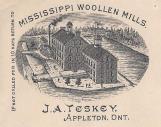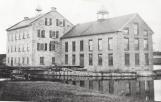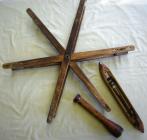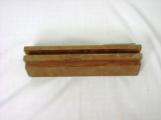1
Mississippi Woollen Mills, J.A. Teskey1862-1900
Appleton, Town of Mississippi Mills, Ontario, Canada
 Credits:
Credits:North Lanark Regional Museum (2012.55.145.5)
Donated by Sheila Babb and Ann E. Love
2
In 1862, Robert Teskey constructed a four storey stone woollen mill, in Appleton, called the Mississippi Woollen Mills. The stone building was constructed using locally quarried limestone and featured prominent quoins, corner stones. The same style of quoins was used on many buildings in Almonte and is now referred to as the 'Almonte' style. The woollen mill influenced the history of Appleton for the next 130 years.3
Mississippi Woollen Mills, four-storey portion built 1862, three-storey built 18801880-1940
Appleton, Town of Mississippi Mills, Ontario, Canada
 Credits:
Credits:North Lanark Regional Museum (2012.13.35)
Donated by Edna Lowry
4
Only a year after building the woollen mill, Robert Teskey retired and left the mill to his son John Adam Teskey. John Adam operated the mill with help from his brother William Rufus Teskey and their brother-in-law William Bredin who was married to their second oldest sister Lucy Teskey.5
John Adam Teskey owner of Mississippi Woollen Mills, 19th centuryCirca 1860-1900
Appleton, Town of Mississippi Mills, Ontario, Canada
 Credits:
Credits:North Lanark Regional Museum (2012.55.145.69)
Photographer: Jordon & Co, (late Bogardus) 229 Greenwich St. (Est. 1846)
Donated by Sheila Babb and Ann E. Love
6
Sarah (Giles) Teskey, wife of John Adam TeskeyCirca 1860-1900
Appleton, Town of Mississippi Mills, Ontario, Canada
 Credits:
Credits:North Lanark Regional Museum (2012.55.145.72)
Photographer: Borgadus, 363 Broadway Cor. Franklin St. New York (Est. 1846)
Donated by Sheila Babb and Ann E. Love
7
Like the sawmill on the west side of the river and the gristmill on the east side, the Mississippi Woollen Mill operated using water power. A large waterwheel converted the water's power to work the industrial equipment inside. Pulleys and levers helped moved the wool from floor to floor in the mill.8
Tag from Appleton's Mississippi Woollen MillsCirca 1862-1900
Appleton, Town of Mississippi Mills, Ontario, Canada
 Credits:
Credits:North Lanark Regional Museum (2012.55.145.3)
Donated by Sheila Babb and Ann E. Love
9
During his early years as owner, John Adam Teskey rented the mills to other companies. According to Jack Brown's, Historical Sketches of Appleton, in 1871 Teskey leased the mill to Charles T. Drinkwater & Son and L. Routh & Co. who manufactured tweeds, flannels and blankets.Later J.A. Teskey took full control of the Mississippi Woollen Mills. In 1880, business was flourishing and the Mississippi Woollen Mill reported an income of $30,000 for producing tweeds. In this same year, John Adam built an addition to the woollen mill to allow for increased production of worsted fabrics. The new building was made of stone with an iron roof and was only three stories high compared to the four-storey original mill.
10
"Appleton Mill" by M. McQuadeCirca 2000-2010
Appleton, Town of Mississippi Mills, Ontario, Canada
 Credits:
Credits:North Lanark Regional Museum (2012.93.1)
Artist: M. McQuade
11
Raw wool went through several steps before it was a finished product at the Mississippi Woollen Mills.SCOURING. When raw wool arrived at the mill it was full of dirt and lanolin (grease). Scouring is a process of washing the wool in warm soapy water to remove all the dirt and grease. Because of wool's felting properties, the scouring process involves very little agitation. Instead, raw wool goes through several soaks and rinses until it is clean.
DRYING. After the scouring process the wet wool was dried using screen tables and hot air. Some Appleton residents may have done the scouring and drying themselves and then brought their clean wool to the mill to be carded and spun.
DYEING. Most sheep's wool is naturally a white or off-white colour. In order to create patterned textiles some of the wool would need to be dyed. Wool could be dyed after the scouring and drying stages, after the carding stage or after the spinning stage.
CARDING. In the carding process the wool is gently combed into strands using small bristles. At the woollen mill large rotating drums with bristles on them would do the carding, while in a domestic setting carding was done by hand with two carding brushes. Once the fibres are straight they are then twisted together into larger strands called rovings.
SPINNING. In this step the rovings are stretched and spun into thin strands of yarn which are stored on swifts or cones. The yarn can then be woven into cloth or knit into various garments.
WEAVING. The Mississippi Woollen Mill produced woven fabrics that were then sold to textile companies to be made into blankets and clothing. In order to make the fabric, large mechanized looms were used to interlace two strands of yarn. A pattern was made by changing the way the strands are interlaced and the colour of the strands.
12
In addition to fully woven cloths ready for the commercial or retail market, the Mississippi Woollen Mills also did custom carding and spinning for local customers.This wooden swift came from the woollen mill and may have been used to prepared skeins of wool for residents of Appleton.
13
Swift, Bobbin and Shuttle used at the woollen millCirca 1862-1950s
Appleton, Town of Mississippi Mills, Ontario, Canada
 Credits:
Credits:Swift: North Lanark Regional Museum (2012.76.2, Donor Elaine Tigges)
Bobbin & Shuttle: Courtesy of Irene (Dunn) Thompson
14
Lag using during 'fulling' process at Woollen Mill19th Century, Early 20th Century
Appleton, Town of Mississippi Mills, Ontario, Canada
 Credits:
Credits:North Lanark Regional Museum (2008.10.1)
Donated by Stewart Neil